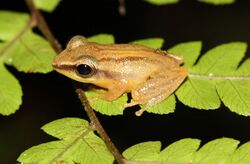Biology:Pseudophilautus tanu
| Sri Lanka petite shrub frog | |
|---|---|

| |
| Scientific classification | |
| Domain: | Eukaryota |
| Kingdom: | Animalia |
| Phylum: | Chordata |
| Class: | Amphibia |
| Order: | Anura |
| Family: | Rhacophoridae |
| Genus: | Pseudophilautus |
| Species: | P. tanu
|
| Binomial name | |
| Pseudophilautus tanu (Meegaskumbura, Manamendra-Arachchi, and Pethiyagoda, 2009)
| |
| Synonyms[3] | |
|
Philautus tanu Meegaskumbura, Manamendra-Arachchi, and Pethiyagoda, 2009[2] | |
Sri Lanka petite shrub frog,[1] (Pseudophilautus tanu), is a species of frogs in the family Rhacophoridae, endemic to southwestern Sri Lanka. This relatively recently described species is only known from two locations in the Galle District, Beraliya and Kanneliya Forest Reserves.[1][3] The specific name tanu is Sinhalese for "slender" and refers to the habitus of this frog.[2]
Description
Three adult males in the type series measure 13.5–13.9 mm (0.5–0.5 in) in snout–vent length; females were not reported. The snout is obtusely pointed. The tympanum is distinct and vertically elongated. The finger tips have discs with circum-marginal grooves; there is no webbing nor dermal fringes. The toes are webbed and bear discs with circum-marginal grooves. The head and body are dorsally pale brown. There are about eight dark-brown stripes of varying width on the dorsum and a dark-brown stripe about as wide as pupil running from the snout through the pupil backward to the flank, fading away on mid-flank. The lower parts are white with some scattered brown pigment.[2]
Habitat and conservation
Pseudophilautus tanu occurs in forest-edges in open shrub areas of the lowland wet zone of Sri Lanka, 24–45 m (79–148 ft) above sea level.[1] Males have been found sitting on leaves of shrubs about 0.5–1 m (2–3 ft) above the ground.[2]
Pseudophilautus tanu is a common species within its habitat.[1] In Kanneliya, it was the most common species in the fern-dominated habitat, along with Pseudophilautus hoipollo.[4] Nevertheless, unprotected forest edge areas are under constant pressure from human activities.[1]
References
- ↑ 1.0 1.1 1.2 1.3 1.4 1.5 IUCN SSC Amphibian Specialist Group (2020). "Pseudophilautus tanu". IUCN Red List of Threatened Species 2020: e.T187832A156588970. doi:10.2305/IUCN.UK.2020-3.RLTS.T187832A156588970.en. https://www.iucnredlist.org/species/187832/156588970. Retrieved 12 November 2021.
- ↑ 2.0 2.1 2.2 2.3 Meegaskumbura, M.; Manamendra-Archchi, M.; Pethiyagoda, R. (2009). "Two new species of shrub frogs (Rhacophoridae: Philautus) from the lowlands of Sri Lanka". Zootaxa 2122: 51–68. http://www.lakdasun.org/forum/doc_base/Two_NewSp_Zootaxa_2009(608).pdf.
- ↑ 3.0 3.1 Frost, Darrel R. (2017). "Pseudophilautus tanu (Meegaskumbura, Manamendra-Arachchi, and Pethiyagoda, 2009)". Amphibian Species of the World: an Online Reference. Version 6.0. American Museum of Natural History. http://research.amnh.org/vz/herpetology/amphibia/Amphibia/Anura/Rhacophoridae/Rhacophorinae/Pseudophilautus/Pseudophilautus-tanu.
- ↑ Bopage, M. M.; Wewalwala, K.; Krvavac, M.; Jovanovic, O.; Safarek, G.; Pushpamal, V. (2011). "Species diversity and threat status of amphibians in the Kanneliya Forest, lowland Sri Lanka". Salamandra 37: 173–177. http://www.salamandra-journal.com/index.php/home/contents/2011-vol-47/255-bopage-m-m-k-wewalwala-m-krvavac-o-jovanovic-g-safarek-v-pushpamal.
Wikidata ☰ Q3409809 entry
 |


